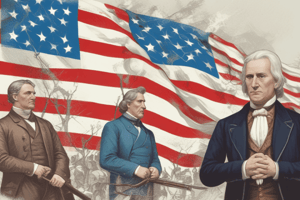Podcast
Questions and Answers
What distinguishes an issue-driven third party from a personality-driven third party?
What distinguishes an issue-driven third party from a personality-driven third party?
- The party's ideologies on social and economic issues
- The number of followers on social media
- The party's ability to win elections
- The focus on a specific policy or issue (correct)
Which type of third party was present during the 19th century?
Which type of third party was present during the 19th century?
- Issue-driven (correct)
- Personality-driven
- Neither
- Both
What is a characteristic of an issue-driven third party's platform?
What is a characteristic of an issue-driven third party's platform?
- Concentration on a specific policy or issue (correct)
- Focus on a broad range of policy issues
- Emphasis on the leader's personal characteristics
- Rejection of the two-party system
During which century was a personality-driven third party present?
During which century was a personality-driven third party present?
What is a key difference between issue-driven and personality-driven third parties?
What is a key difference between issue-driven and personality-driven third parties?
What is the primary focus of an issue-driven third party?
What is the primary focus of an issue-driven third party?
Which of the following is a characteristic of a personality-driven third party?
Which of the following is a characteristic of a personality-driven third party?
What type of third party was present during the 19th century in the United States?
What type of third party was present during the 19th century in the United States?
Which of the following is an example of an issue-driven third party platform?
Which of the following is an example of an issue-driven third party platform?
In which century did personality-driven third parties emerge as a significant force in American politics?
In which century did personality-driven third parties emerge as a significant force in American politics?
Flashcards are hidden until you start studying
Study Notes
Third Party Types
- An issue-driven third party focuses on a specific policy or issue, aiming to influence the political agenda.
- A personality-driven third party revolves around a charismatic leader, often with a personal following.
19th Century Third Parties
- The Liberty Party (1840) opposed slavery and advocated for its abolition.
- The Free Soil Party (1848) sought to limit slavery's expansion and promote westward expansion.
- The Populist Party (1892) addressed farmers' and workers' concerns, pushing for monetary reform and government regulation.
- The Prohibition Party (1869) aimed to ban alcohol and advocate for moral reform.
20th Century Third Parties
- The Progressive Party (1912) focused on social and political reform, led by Theodore Roosevelt.
- The Socialist Party (1901) promoted socialist ideals, led by Eugene Debs.
- The American Independent Party (1968) was a right-wing populist party, led by George Wallace.
Studying That Suits You
Use AI to generate personalized quizzes and flashcards to suit your learning preferences.




